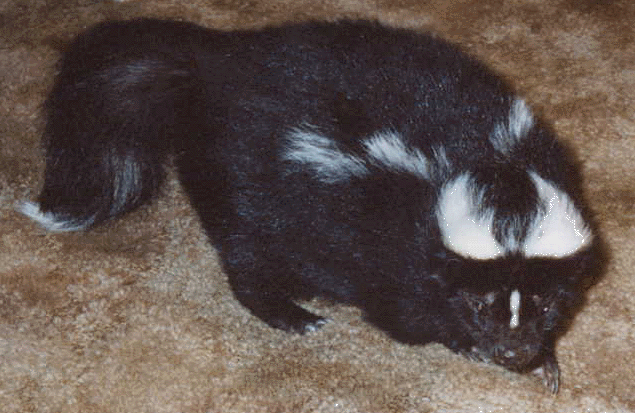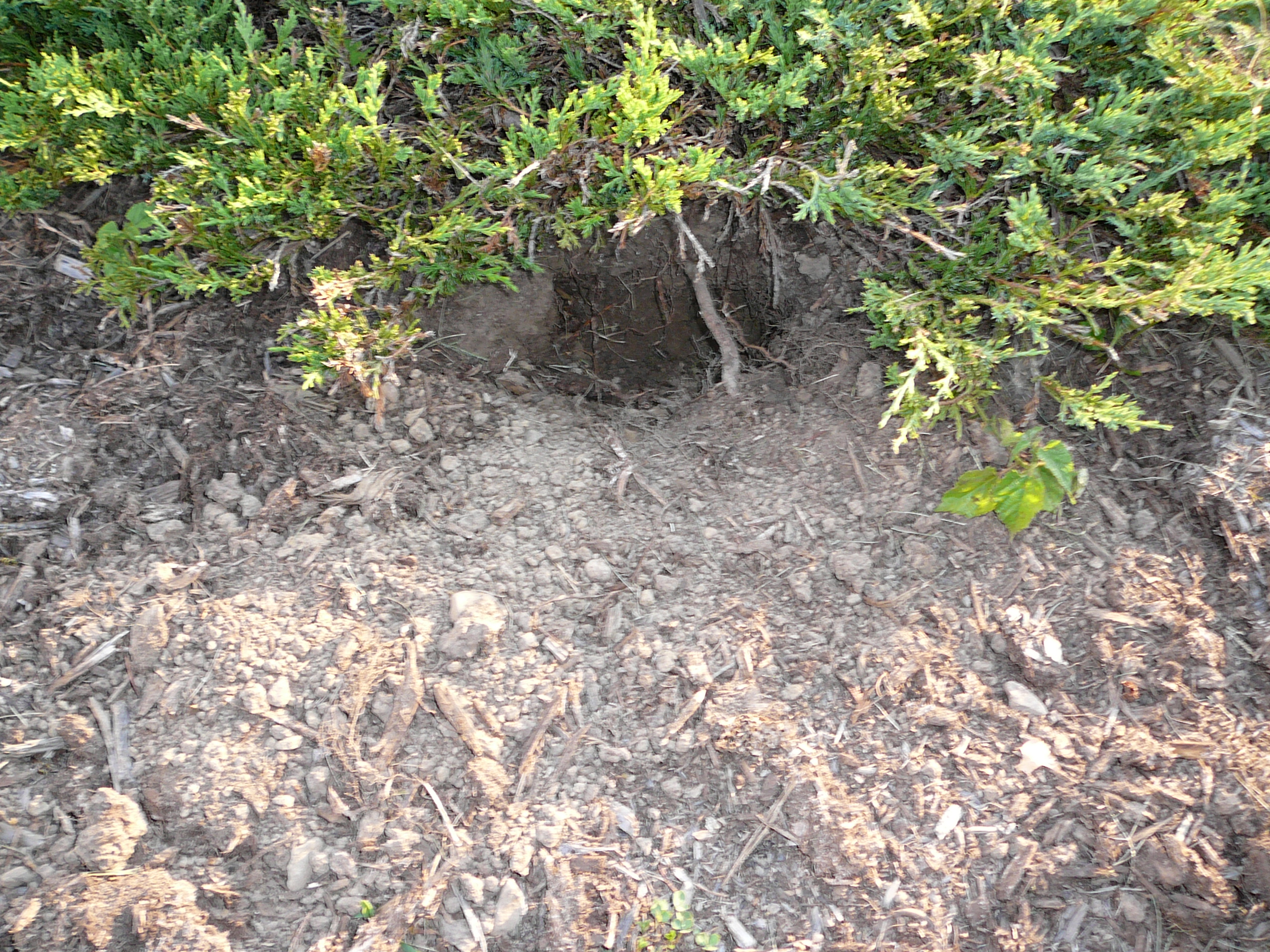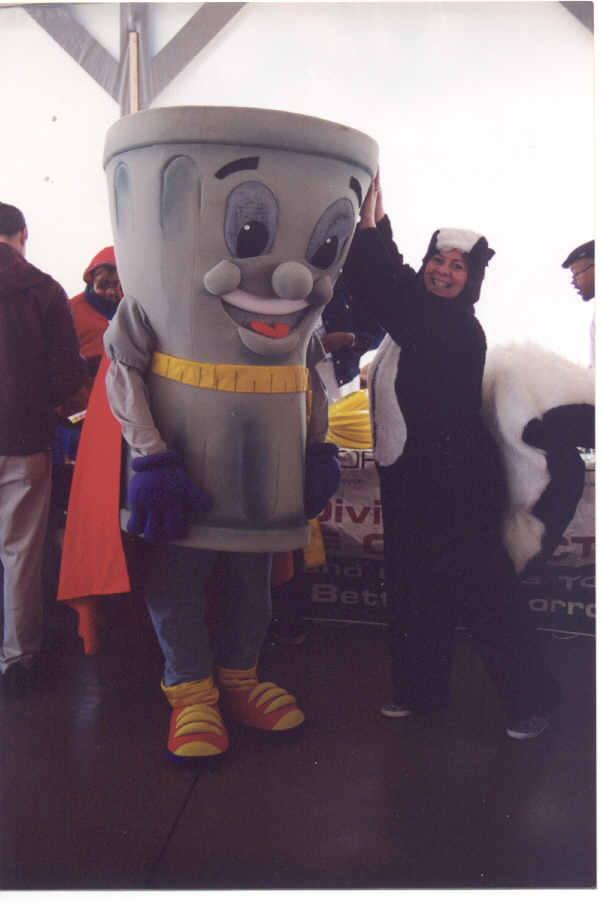
 |
Previous | SkunkHaven.Net Index | Next |
Skunks are unusual, funny, amazing, friendly animals that just have a bad reputation. Most complaints about skunks are attributable to rumor and falsehood, and a pungent defensive weapon. Skunks learn quickly and remember well, especially when it comes to food, this often leads to "repeat offenses" and more bad press.
Skunks were once thought to be part of the same animal family as weasels, ferrets, and badgers. Now, thanks to DNA testing, they are recognized as more distantly related to other animals and were identified as a separate family:
| Order - Carnivora |  |
| Family - Mephitidae | |
| Species - | |
| Conepatus (Hog-nosed Skunks) | |
| Mephitis | |
| Mephitis macroura (Hooded Skunk) | |
| Mephitis mephitis (Striped Skunk) | |
| Mydaus (Stink Badgers) | |
| Spilogale (Spotted Skunks) | Mephitis mephitis - At Home |
Skunks are sometimes referred to as Polecats, but these are not related animals. Polecats are, most often, old-world ferrets or weasles.
The common striped skunk is the most well known in the United States, due to its extensive habitat range, its size (up to 12 pounds), and its distinctive striped markings. Domestic skunks are commonly bred from direct lines of the striped skunk, however some cross breeding between the striped and hooded skunks is accepted as cause for the varied colors and pattern markings on domestic skunks.
Skunks can spray before their eyes are open. Adult skunks are accurate within 10 feet and can spray up to 25 feet. Pet skunks are descented by the breeders at 2-to-5 weeks of age. In some states it is legal for the breeders to sell skunks that are not descented, breeders may charge more or less than the going rate for skunks that are not descented. More information on skunk spray can be found on Dr. William F. Wood's Skunk Spray page.
Wild skunks warn predators and competitors by stomping their front feet and raising their tails in full bloom. Skunks will run directly toward a threat and stop (sometimes within inches), then stomp and hiss or squeal. If the enemy doesn't heed the warnings the skunk will turn and spray. Spotted skunks even do handstands as a warning. Domestic skunks use the same tactics, often as a form of play, luckily we've had the skunks descented and it's all show.
Skunks make various sounds as a warning to enemies and in play. Skunks can screach like a pig and whine when mad, chip like a bird to get attention (especially from other skunks), wimper like a dog when sad or freightened, grumble and grunt when upset, and they even lip-smack when contented. Every skunk will stomp, sometimes very forcefully, when they are upset.
Wild skunks come out in the evening and early morning hours usually resting at night and sleeping during the day. In the winter and early spring skunks may be seen out of their dens at almost any time of day, especially before and after long periods of snow cover or prolonged cold weather. Skunks do not hibernate in winter; they do sleep more but will come out of the den to forage for food when they are not snowed in. Pet skunks can be easily trained to be up in the daytime and sleep at night; they usually retain some of the wild traits of sleeping heavy on cold snowy nights and roaming the house when it warms outside.
Skunks usually take over groundhog, rabbit, or fox dens; the typical den is along a stream or ravine. Skunks will even allow groundhogs and rabbits to remain in the same den (except when the females have young kits). Skunks are tolerant of other skunks, especially their family members, often a male will den with a harem of females in the winter breeding months. Pet skunks will make one or two dens that they will sleep in, a small cage or pet carrier with a blanket usually works fine as a sleeping den, and a pillow or blanket in a sunny spot is good for the daytime. Missing socks, shirts, blankets, or any cuddly toys or fabric can usually be found in or near these den spots.
Wild skunks only live a few years (maximum of about 5) due to disease, predatory birds, and the intentional and unintentional acts of man. Some people say skunks live to be up to 20 years old, we have found that skunks only live to be 6-10 years old. Some have lived past that age but it is rare.
The main predators of the skunk are owls and other large birds of prey. Most birds cannot smell much if at all and are not bothered by the skunk spray odor, and the birds strike fast from above, so a skunk has little defense in their attacks. For this reason, pet skunks should not be left outside unattended, a hawk could easily swoop in and severely injure or kill a skunk.
Skunks are often blamed for causing problems in neighborhoods, digging holes, spraying dogs, etc. Humans continue to trap and kill skunks as nuisance wildlife.
 |
Skunks will dig to find grubs. |
Skunks can not jump up or knock over your garbage can.
 |
Skunks are too small to climb into a trash can. |
Typically a stray dog or raccoon will push the trash can over, skunks often follow along afterward and reap the benefits. Feed your cats and dogs inside, do not leave food outside over night. Keep lids on garbage cans.
Skunks can only run about ten miles per hour and will not try to outrun a predator. One reason autos are so dangerous to the skunk is simply the speed of approach. The skunk will stand still to spray, and most drivers wrongly expect the skunk to move away as other wild animals do.
Skunks are omnivores, and will eat almost anything. In the wild they eat mainly insects, worms, fruits, berries, nuts, and some plants. Skunks dig up ground-nesting bees and eat almost everything they find in the nest. Opportunistic hunters, the skunk will catch mice, snakes, toads, and other small amphibians and mammals they come across. Skunks also eat dead animals and remains left by foxes, coyotes, wolves, etc. Pet skunks can be very persistent in finding food; doors, drawers, or shelves won't stop a skunk from reaching a tasty morsel if the skunk really wants it.
Skunks spend most of their time outside the den foraging for food. They may frequent good feeding spots over their entire life and females may even train their offspring where these places are. Pet skunks should be very active at feeding times (the signs of a healthy skunk) and less active afterward (the sign that they are getting a proper diet). If a skunk regularly ignores mealtimes consider decreasing the amount of food given each day; if a skunk gobbles down everything at every meal and stays up for several hours looking for more you probably need to increase the amount or look at the balance of nutrients the skunk is getting.
Skunks do not drink much water; this is one of the leading factors in the unfounded fear of rabies (hydrophobia) in skunks. Typically they get most of their water requirement from their diet. Skunks usually drink soon after eating, if at all, but you should always leave fresh water available.
Skunk claws are used for digging up grubs, insects, etc. They usually dig long shallow holes when searching for grubs. Our domestic skunks use their claws for digging up rugs and opening doors, drawers, and packages. The nails should be cut every month.
| Domestic skunks are available in various colors... | ...and various pattern types... | ||
| Albino (White with Pink Eyes) | Star, Falling Star | ||
| White on White (White with Dark Eyes) | |||
| Tan (Apricot, Champagne, Lavender) | Classic Stripe (Single Stripe, Multi-Stripe) | ||
| Smoke (Gray, Silver) | |||
| Brown (Chocolate, Reddish-Brown) | Chip (Distinct white spots on all four legs) | ||
| Mahogany | |||
| Black | Marble and Swirl | ||
You can look at some of the colors and patterns.
Skunks are not good pets for everyone. They require lots of attention, time, patience, and love. They must be held often when babies so that they will have a good temperament as adults.
Skunks are not legal in all states. Contact your State Wildlife Department and/or and local wildlife officer regarding the laws on skunk possession and the license that is required in your area. (Refer to our Legal States page and/or Aspen Skunk Rabies Research, Inc. for more information on legal states.)
KEEP YOUR RECEIPT to prove your skunk did not come from the wild. Always get the state permit and USDA License numbers of the breeder/dealer/store where you are buying. Although you may not get into trouble, buying from unlicensed dealers/stores encourages this illegal trade and encourages the taking of animals from the wild.
If you need help contacting your Wildlife Officer, Health Department, or other state and local officials please contact us and we will provide assistance.
Skunks are not immune to rabies, there is no proof that skunks survive longer than other animals of the same size after being infected with rabies. Skunks are rumored to be THE major vector of rabies in some areas, but when complete research is done it is typically found that the skunks are no more (or less) susceptible to a rabies outbreak than raccoons, fox, and other small mammals in the same area. There is no conclusive evidence that skunks are more likely to suffer "active" rabies symptoms (foaming at the mouth, madness, attacking), the skunks with "passive" (paralytic) rabies usually die in their dens away from sight.
Domestically bred skunks are not rabies carriers, the skunk MUST come into direct contact with another animal "shedding" rabies virus to be infected. Since our pet skunks are never outside unattended there is little, if any, chance of a pet skunk having rabies. Legal breeders ensure their stocks are not compromised by using double enclosure fences and constantly monitoring the health of each animal.
Link to U.S. CDC Rabies Epidemiology.
© 2001-2009 Skunk Haven™ Skunk Rescue, Shelter, and Education, Inc.
Revised 04/12/09 (kw)
 |
||
| Previous | SkunkHaven.Net Index | Next |
|
|
Validate HTML 4.01 |